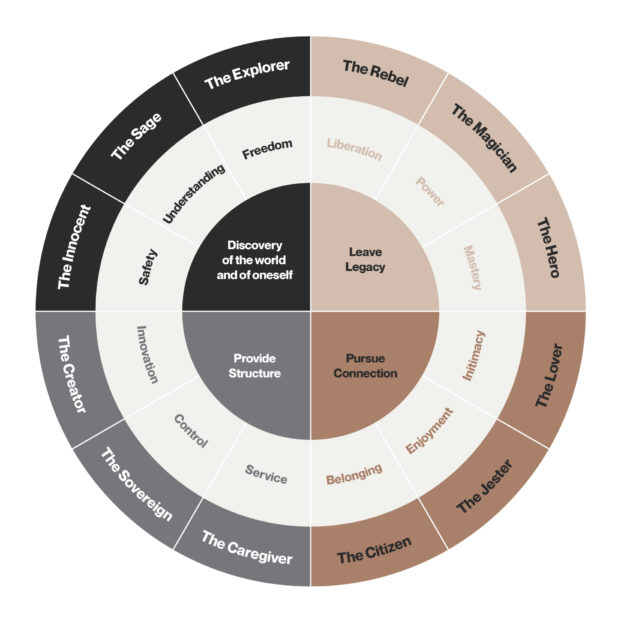Archetypes are universal behavioural models that transcend time and culture. They offer a subliminal frame of reference that target clienteles can relate to no matter their journey, emotions or deepest aspirations, helping build a more cohesive and uniform brand experience.
“An archetype is a universally familiar character that transcends time, place, culture, gender and age. It represents an eternal truth.”
– Jon Howard-Spink, partner, Quiet Storm Advertising, London
Most brands that consumers hold an emotional relationship with are built around an archetype. One need only think of Nike (the Hero), Jeep (the Explorer), the BBC (the Sage) or Rolex (the Ruler), to name a few.
While archetypes may stem from mythology, it’s Swiss psychologist Carl Gustav Jung who further developed the concept by suggesting that these archetypes were expressions of the collective unconscious and could be explored to better understand how each person’s psyche works.
It’s important to note that archetype and stereotype should not be used interchangeably. A stereotype is used to denote how one social group views another, while an archetype is a universal concept.
In the field of branding, archetype usage is based on the notion that these universal concepts are powerful enough to evoke certain emotions in consumers, an idea that was popularized by Margaret Mark and Carol S. Pearson’s book, The Hero and the Outlaw: Building Extraordinary Brands Through the Power of Archetypes.
Archetypes are generally organized according to four overarching motivations:
” By helping us bridge the gap between the right and left sides of the brain, archetypes allow us to establish a relevant and structured creative process, while leaving room for creativity.”
– Yann Mooney, Vice President, Creative, at BrandBourg
The above motivations are supported by 12 basic archetypes, each with their own inspiring name, such as the Sage, the Lover, the Creator and the Magician, and each with their own personality, strengths and challenges. These 12 fundamental models encompass 48 others, giving brands the opportunity to add more depth and texture to their strategy and creative.
When an archetype is woven into the brand strategy, an unconscious connection between the brand and the person interacting with it is triggered. Therefore, a brand that adopts the Hero archetype, for example, can seek to inspire a sense of accomplishment in its customers and employees. While one that aspires to the Explorer can appeal to people’s desire for adventure.
It should be noted that archetypes are different from brand personas. While both concepts seek to establish an emotional connection with their target, archetypes are based on a symbolic, universal concept that takes a brand’s entire identity into consideration. Brand personas, on the other hand, are specific, detailed representations of the ideal client.
“Exploring archetypes was a deep dive into our brand essence, and it revealed surprising aspects of our brand. These revelations gave us an authentic and compelling story to tell – one that blended reason and emotion and resonated deeply with our targets.”
– Marie Lefebvre, Director of Communications and Public Relations, Ordre des ingénieurs du Québec
While many branding specialists have adopted the use of archetypes, at BrandBourg, we’ve truly made them our own. This tool has become a staple at our brand workshops, as it allows us to collect a wide variety of important information and build comprehensive, high-performing brand identities.
“Our use of archetypes at our hands-on workshops with clients has us tagged as veritable brand psychoanalysts by many. It’s a title we’re perfectly comfortable with, and one that we’re truly proud of.”
– Lucie Tanguay, Practice Lead, Brand Strategy, at BrandBourg
“Knowing your brand personality is key. Too often, we don’t distinguish it from that of the business owner. And yet, they are distinct entities and must be communicated differently. Defining brand archetypes is an excellent way to promote corporate culture while getting teams involved in a motivating, inspiring exercise. What emerges is a valuable tool that helps us understand how our brand is perceived on the market, but also how our own employees experience it. The archetypes workshop was transformative for EcoloPharm; it frames a marketing strategy that adds value to our brand through an improved understanding of and commitment to our brand personality.”
– Sandrine Milante, President and CEO, EcoloPharm

“We were very pleased to engage BrandBourg with our Corporate Brand strategy work – considering our need to refresh our brand image in 2024 and reflect our pivot to becoming more consumer and customer centric.
Our renewed vision, mission, value – and our promise – served as a strong underpinning for the creative foundation work required to guide our corporate brand strategy. As we worked to clearly define our brand behaviours, personality, tone & manner – we initially struggled with how the brand would ultimately express itself – an expression / experience that should feel immediately authentic and could effectively tell our unique story. It was also critical for us to ensure we differentiated ourselves from our competitors.
This impasse was effectively resolved by introducing a different approach – employing a brand archetypes framework into the process. This was a key unlock to our impasse. It helped us find a ‘centre of gravity’ in regard to our brand’s creative expression – anchored in our vision, mission, and values. And it allowed us to clearly differentiate ourselves from a branding perspective from our competitors.”
– Paul Tralla, Growth and Business Transformation, Trophy Foods Inc.
View more relevant articles